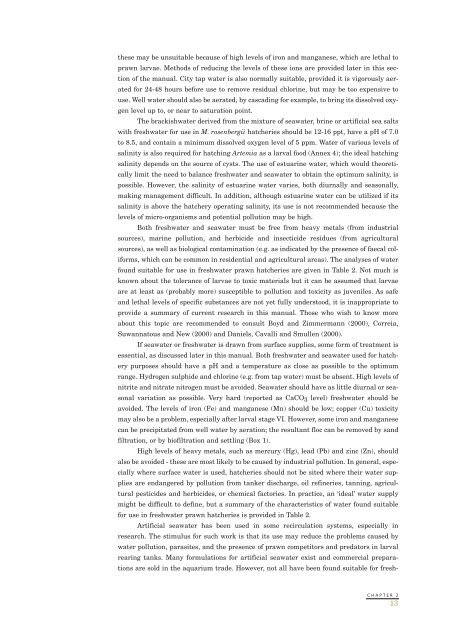Create successful ePaper yourself
Turn your PDF publications into a flip-book with our unique Google optimized e-Paper software.
these may be unsuitable because of high levels of iron and manganese, which are lethal toprawn larvae. Methods of reducing the levels of these ions are provided later in this sectionof the manual. City tap water is also normally suitable, provided it is vigorously aeratedfor 24-48 hours before use to remove residual chlorine, but may be too expensive touse. Well water should also be aerated, by cascading for example, to bring its dissolved oxygenlevel up to, or near to saturation point.The brackishwater derived from the mixture of seawater, brine or artificial sea saltswith <strong>freshwater</strong> for use in M. rosenbergii hatcheries should be 12-16 ppt, have a pH of 7.0to 8.5, and contain a minimum dissolved oxygen level of 5 ppm. Water of various levels ofsalinity is also required for hatching Artemia as a larval food (Annex 4); the ideal hatchingsalinity depends on the source of cysts. The use of estuarine water, which would theoreticallylimit the need to balance <strong>freshwater</strong> and seawater to obtain the optimum salinity, ispossible. However, the salinity of estuarine water varies, both diurnally and seasonally,making management difficult. In addition, although estuarine water can be utilized if itssalinity is above the hatchery operating salinity, its use is not recommended because thelevels of micro-organisms and potential pollution may be high.Both <strong>freshwater</strong> and seawater must be free from heavy metals (from industrialsources), marine pollution, and herbicide and insecticide residues (from agriculturalsources), as well as biological contamination (e.g. as indicated by the presence of faecal coliforms,which can be common in residential and agricultural areas). The analyses of waterfound suitable for use in <strong>freshwater</strong> prawn hatcheries are given in Table 2. Not much isknown about the tolerance of larvae to toxic materials but it can be assumed that larvaeare at least as (probably more) susceptible to pollution and toxicity as juveniles. As safeand lethal levels of specific substances are not yet fully understood, it is inappropriate toprovide a summary of current research in this manual. Those who wish to know moreabout this topic are recommended to consult Boyd and Zimmermann (2000), Correia,Suwannatous and New (2000) and Daniels, Cavalli and Smullen (2000).If seawater or <strong>freshwater</strong> is drawn from surface supplies, some form of treatment isessential, as discussed later in this manual. Both <strong>freshwater</strong> and seawater used for hatcherypurposes should have a pH and a temperature as close as possible to the optimumrange. Hydrogen sulphide and chlorine (e.g. from tap water) must be absent. High levels ofnitrite and nitrate nitrogen must be avoided. Seawater should have as little diurnal or seasonalvariation as possible. Very hard (reported as CaCO 3 level) <strong>freshwater</strong> should beavoided. The levels of iron (Fe) and manganese (Mn) should be low; copper (Cu) toxicitymay also be a problem, especially after larval stage VI. However, some iron and manganesecan be precipitated from well water by aeration; the resultant floc can be removed by sandfiltration, or by biofiltration and settling (Box 1).High levels of heavy metals, such as mercury (Hg), lead (Pb) and zinc (Zn), shouldalso be avoided - these are most likely to be caused by industrial pollution. In general, especiallywhere surface water is used, hatcheries should not be sited where their water suppliesare endangered by pollution from tanker discharge, oil refineries, tanning, agriculturalpesticides and herbicides, or chemical factories. In practice, an ‘ideal’ water supplymight be difficult to define, but a summary of the characteristics of water found suitablefor use in <strong>freshwater</strong> prawn hatcheries is provided in Table 2.Artificial seawater has been used in some recirculation systems, especially inresearch. The stimulus for such work is that its use may reduce the problems caused bywater pollution, parasites, and the presence of prawn competitors and predators in larvalrearing tanks. Many formulations for artificial seawater exist and commercial preparationsare sold in the aquarium trade. However, not all have been found suitable for fresh-CHAPTER 213
















